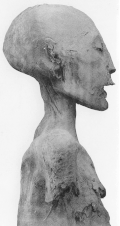The Younger Lady
The Younger Lady är det informella namnet på mumien KV35YL[1] med inventarienummer CG 61072 som hittades 1898 i [2] i Konungarnas dal i Egypten av arkeologen Victor Loret.[3] Hennes mumie hittades utan kista tillsammans med mumien för Tiye och en oidentifierad prins i kammare Jc i graven KV35. Sannolikt har The Younger Lady ursprungligen blivit begravd någon annanstans, och först senare flyttats till KV35.[2]
DNA-tester visar att The Younger Lady var syster till Akhenaton, och att hon även tillsammans med Akhenaton är förälder till Tutankhamon. Hennes föräldrar var Amenhotep III och Tiye.[4][1]
Identifiering
Realistiska kandidater för The Younger Ladys identitet är:
- ca 35-åriga Nefertiti[5]
- ca 30-åriga Kiya (Akhenatons andra fru)[5]
- Sitamun (dotter till Amenhotep III och Tiye)[2]
- ca 20–25-åriga Meritaton (Nefertitis och Akhenatons äldsta dotter)[5]
Flera studier har identifierat The Younger Lady som Nefertiti, inte minst på grund av de visuella likheterna mellan mumien och den byst av Nefertiti som finns på Neues Museum i Berlin.[5][6] Bedömningar baserade på mumiens skelett och kindtänder tyder på att The Younger Lady var yngre än 25 år vid dödstillfället, och röntgenundersökningar visar att hon kan ha varit så ung som 16 när hon avled.[2] The Younger Lady är 1,58 m lång.[7]
Den omständighet att The Younger Lady begravdes tillsammans med en drottning och en prins och att hon hade rakat huvud, hade dubbla hål i öronen, tecken på hårt åtsittande pannband och armen i en kunglig position tyder högst sannolikt på att The Younger Lady var kunglig.[2] Mumifieringstekniken som har använts för The Younger Lady tyder på att hon är mumifierad vid tiden för Amenhotep II (r. 1428–1397 f.Kr.)[2] eller under den senare hälften av den artonde dynastin.[7]
Referenser
Noter
- ^ [a b] Hawker, Libbie (2016). ”An extremby long history note” (på engelska). Eater of Hearts: Part 3. ASIN: B01CD8FPME. Running Rabbit Press. https://books.google.se/books?id=YT2mCwAAQBAJ&lpg=PT202&dq=KV35YL&hl=sv&pg=PT202#v=onepage&q=KV35YL&f=false
- ^ [a b c d e f] ”Unidentified Mummies” (på engelska). The Theban Royal Mummy Project. http://anubis4_2000.tripod.com/mummypages2/UnidentifiedandMissing.htm. Läst 21 mars 2016.
- ^ ”KV 35 (Amenhetep II)” (på engelska). © 1997-2010 Theban Mapping Project. Arkiverad från originalet den 2 augusti 2018. https://web.archive.org/web/20180802234436/http://www.thebanmappingproject.com/sites/browse_tomb_849.html. Läst 9 januari 2016.
- ^ ”Ancestry and Pathology in King Tutankhamun's Family” (på engelska). American Medical Association. https://jamanetwork.com/journals/jama/fullarticle/185393. Läst 19 mars 2016.
- ^ [a b c d] ”The mummy Cairo CG 61072 “Younger Lady from KV 35” (på engelska). Yearbook of Physical Anthropology. "Volume 159". Wiley Periodicals, Inc. January 2016. sid. 225–227. http://onlinelibrary.wiley.com/doi/10.1002/ajpa.22909/full
- ^ ”Queen Nefertiti’s Mummy Found?” (på engelska). Discovery News. Arkiverad från originalet den 2 april 2016. https://web.archive.org/web/20160402231955/http://www.newsfinder.org/site/more/queen_nefertitis_mummy_found/. Läst 2 mars 2016.
- ^ [a b] ”DO WE HAVE THE MUMMY OF NEFERTITI?” (på engelska). Marianne Luban ©1999. http://www.oocities.org/scribelist/do_we_have_.htm. Läst 21 mars 2016.
Tryckta källor
- Hawker, Libbie (2016) (på engelska). Eater of Hearts: Part 3. ASIN: B01CD8FPME. Running Rabbit Press. http://www.amazon.com/Eater-Hearts-Part-Coming-Forth-ebook/dp/B01CD8FPME
- (på engelska) Yearbook of Physical Anthropology. "Volume 159". Wiley Periodicals, Inc. January 2016. http://onlinelibrary.wiley.com/doi/10.1002/ajpa.v159.S61/issuetoc
Media som används på denna webbplats
Författare/Upphovsman: Magnus Manske, Licens: CC BY-SA 3.0
Object in the Ägyptisches Museum Berlin (Egyptian museum, building of the New Museum), Berlin.
Front view of the "Younger Lady Mummy" found in tomb KV35. This image clearly displays the damage thought to be done by ancient tomb robbers (right arm torn from body, chest caved in) and what is now thought to have been a lethal injury to the left cheek/jaw.
Image derived from Grafton Elliot Smith's "The Royal Mummies" (Plate XCIX), which was first published in 1912. The author died in 1937 so the book/image is in the public domain.
Recent genetic tests have conclusively demonstrated that this individual was the mother of Tutankhaum. The JAMA eSupplement from Feb. 17, 2010 concludes that "The statistical analysis revealed that the mummy KV55 is most probably the father of Tutankhamun (probability of 99.99999981%), and KV35 Younger Lady could be identified as his mother (99.99999997%)." (eSupplement, p.3).Front view of the "Younger Lady Mummy" found in tomb KV35. This image clearly displays the damage thought to be done by ancient tomb robbers (right arm torn from body, chest caved in) and what is now thought to have been a lethal injury to the left cheek/jaw.
Image derived from Grafton Elliot Smith's "The Royal Mummies" (Plate XCIX), which was first published in 1912. The author died in 1937 so the book/image is in the public domain.
Recent genetic tests have conclusively demonstrated that this individual was the mother of Tutankhaum. The JAMA eSupplement from Feb. 17, 2010 concludes that "The statistical analysis revealed that the mummy KV55 is most probably the father of Tutankhamun (probability of 99.99999981%), and KV35 Younger Lady could be identified as his mother (99.99999997%)." (eSupplement, p.3).




